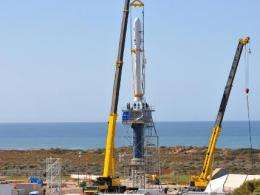NASA Releases Orbiting Carbon Observatory Accident Summary

(PhysOrg.com) -- A NASA panel that investigated the unsuccessful Feb. 24 launch of the Orbiting Carbon Observatory, or OCO, has completed its report.
NASA's OCO satellite to study atmospheric carbon dioxide launched aboard a Taurus XL rocket from Vandenberg Air Force Base in California on Feb. 24 at 4:55 a.m. EST, but it failed to reach orbit.
The Mishap Investigation Board led by Rick Obenschain, deputy director at NASA's Goddard Space Flight Center in Greenbelt, Md., verified that the Taurus launch vehicle fairing failed to separate upon command. The fairing is a clamshell structure that encapsulates the satellite as it travels through the atmosphere. The failure to shed the fairing mass prevented the satellite from reaching its planned orbit and resulted in its destruction.
The board identified four potential causes that could have resulted in the fairing not separating:
* A failure of the frangible joint subsystem. A frangible joint is an explosive device that provides instantaneous separation of flight vehicle structures while maintaining confinement of explosive debris.
* A failure in the electrical subsystem that prevented sufficient electrical current to initiate the required ordnance devices.
* A failure in the pneumatic system, which supplies pressure to thrusters which separate the fairing.
* A cord snagged on a frangible joint side rail nut plate.
The panel also provided recommendations to prevent any future problems associated with the four hardware components that could have caused the OCO accident.
The six-member board began its investigation in early March. The panel conducted hardware testing; performed and reviewed engineering analysis and simulation data; reviewed telemetry data; collected and secured more than 2,000 documents; and conducted 78 interviews of critical personnel associated with the mission.
The official report of the board contains information restricted by U.S. International Traffic in Arms Regulations and company sensitive proprietary information. As a result, the board has prepared a summary of its report, which provides an overview of publicly releasable findings and recommendations regarding the OCO mission failure. The summary is available at: www.nasa.gov/oco .
Provided by JPL/NASA (news : web)



















